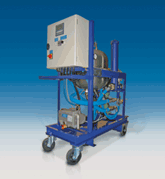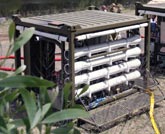Contamination Sources:
It is widely recognized that water and particulate contamination can degrade critical physical properties of hydraulic fluid and lead to premature wear as well as possible malfunction of hydraulic system components.
Maintenance: during component manufacturing and overhaul, contaminants are left behind and then introduced to the aircraft when reinstalled. This can be in the form of tiny metal fragments, contaminated fluids used in acceptance testing, FOD caps missing during handling, or solvents used in the manufacturing, cleaning, or testing of the component.
Component wear during operations: although the onboard filter is designed to reduce this type of contamination, over time, fluid systems can become so contaminated that the onboard filter will just clog up quickly once installed in a heavily contaminated aircraft. Worn or shedding hoses also leave behind debris that clogs the onboard filter and contaminates the entire system. If poor onboard filtration is used, the contaminant not caught by the filter will make it downstream into valves, pumps and other components creating even more wear. As the components wear, the wear debris makes it back to the filter element and if that debris is not captured because of poor filtration, the debris contaminant itself creates more wear. We call this loop the “chain reaction of wear”.
Ground support equipment: even in a closed system, worn system seals, system fill caps left off, or inadequate cleaning around the system fill port before connecting ground equipment allow contaminants to enter.
Contamination Control:
A better way to manage fluid contamination, with proven benefits!
Field investigations have shown that the most common reason for used hydraulic fluid being drained and discarded is because it has become contaminated to such a degree that it could damage the hydraulic system. However, laboratory studies have determined that even though the hydraulic fluid may be heavily contaminated, its ability to perform has not been lessened. Analysis during the laboratory phase of past Pall purification projects revealed that used hydraulic fluid retained nearly all of its required performance capabilities, i.e. viscosity, corrosion protection, etc.
The approved methodology of returning used hydraulic fluids to spec performance, involves the removing of contaminants from fluids and revitalizing fluid additives.
By using the correct hydraulic fluid purification process for removal of water and particulates, you can maintain hydraulic fluid at the required performance specification levels and avoid pump wear, valve spool sticking, seal wear, cylinder scoring, and erosion of system components, decreased lubricity, viscosity, load-carrying ability and other degradation.
- Purification of Hydraulic Fluids
- Removal of water and volatile solvents
- Prevents corrosion of hydraulic system components
- Removal of solid particulates/removal of air
- Prevents hydraulic system component wear
- Prevents cavitation, sluggish system response, hydraulic fluid degradation
- Removal of water and volatile solvents
- Fluid purification methods include:
- Flash Distillation
- Vacuum Dehydration
Why choose a Purification solution?
- The use of a certified automated hydraulic fluid purifier, optimizes processing time and eliminates the labor required to collect and analyze fluid samples
- Reutilizing hydraulic fluid to specification performance directly relates to less new fluid procured, less fluid required to be kept in stock to meet fluid usage requirements, and less fluid required for deployments (deploy with a small amount of oil and an oil purifier vs. deploying with large quantities of oil)
- Implementation of hydraulic fluid recycling has a significant impact on meeting pollution prevention goals, conserving natural resources, and reducing costs associated with both the procurement of new and disposal of used hydraulic fluids
With over 5000 purifiers sold world-wide, Pall brings over 3 decades of experience in providing purification solutions for nearly all industrial markets. Our purifiers help you bring hydraulic fluid to specification performance and increase operational readiness, system performance and reliability.





Marine Fluid Purifiers
Application: Commercial Marine Vessels, Naval Submarines, Naval Surface Ships
Portable Fluid Purifiers
Application: Commercial Fixed Wing, Commerial Rotary Wing, Military Fixed Wing, Military Rotary Wing
HNP023 Series Oil Purifier
Application: Commercial Fixed Wing, Commerial Rotary Wing, Military Fixed Wing, Military Rotary Wing
HNP076 Series Oil Purifier
Application: Commercial Fixed Wing, Commerial Rotary Wing, Military Fixed Wing, Military Rotary Wing
Mobile Water Purification Units
Application: Military and Civil
Features & Benefits
FEATURES
|
|
|
|
|
|
|
|
|
|
|

